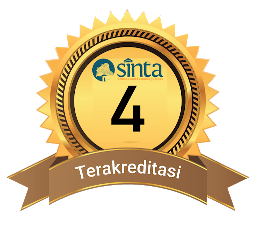Pengaruh Metode Pembelajaran Brainstorming Terhadap Kemampuan Berpikir Kreatif Kimia Peserta Didik Kelas Xi SMA Negeri 3 Mataram Tahun Ajaran 2022/2023
DOI:
10.29303/cep.v8i1.5691Published:
2025-05-31Issue:
Vol. 8 No. 1 (2025): Edisi MeiKeywords:
brainstorming learning method, creative thinkingArticles
Downloads
How to Cite
Abstract
This study aims to determine the influence of brainstorming learning methods on the ability to think creatively in chemistry of grade XI science students. The type of research used is Quasi Experiment with a nonequivalent control group pretest-posttest design. The population of this study is all students of grade XI science for the 2022/2023 school year, totaling 158 students distributed in five classes. The sample used in this study was 60 students who were determined by cluster random sampling technique. Through random, class XI Science 4 was determined as a control class and in learning using conventional learning methods, namely lectures and discussions, and class XI Science 3 as an experimental class using brainstorming learning methods. Data on creative thinking skills were collected by test techniques using instruments in the form of description questions. The research hypothesis was tested using an independent t-test to analyze the difference between the n-gain of the control class and the experimental class using the help of SPSS 25 software. An independent t-hypothesis test yields a sig. (1-tailed) of 0.000 is less than the significance value (0.05). In the N-Gain test, experimental class N-Gain 0.6353 was obtained which was greater than that of control class 0.4255. Based on the t test and N-gain comparison, there is a positive and significant influence of brainstorming learning methods on students' creative thinking skills.
References
Amtiningsih, S., Dwiastuti, S., & Puspita Sari, D. (2016). Peningkatan Kemampuan Berpikir Kreatif melalui Penerapan Guided Inquiry dipadu Brainstorming pada Materi Pencemaran Air. Proceeding Biology Education Conference, 13(1), 868–872.
Liani, E., Hamdani, D., & Risdianto, E. (2018). Penerapan Model Problem Based Learning dengan Metode Brainstorming untuk Meningkatkan Kemampuan Pemecahan Masalah Siswa di SMAN 3 Kota Bengkulu. Jurnal Kumparan Fisika, 1(2), 20–24. https://doi.org/10.33369/jkf.1.2.20-24
Mialita, Hudaidah, R. susanti. (2018). Pengaruh Pendekatan Pembelajaran Brainstorming Terhadap Kemampuan Berpikir Kritis Peserta Didik Pada Mata Pelajaran Sejarah Di Kelas X Mia Di Sma Negeri 10 Palembang. 7(1).
Putri, D. P. E. (2021). Pengembangan Multimedia Pembelajaran Interaktif Kimia Berbasis Android. 7–10.
Rosa, Novrita. M. (2015). Pengaruh Sikap Pada Mata Pelajaran Kimi dan Konsep Diri Terhadap Prestasi Belajar Kimia. Jurnal Formatif 2(3): 218-226.
Sofiah, Peniati, E., & Lisdiana. (2016). Efektivitas Model Project Based Learning Dengan Brainstorming Terhadap Keterampilan Berpikir Kritis Pada Pembelajaran Sistem Saraf. Journal of Biology Education, 5(1), 72–78.
Sudjana, D. (2015). Kartu Kation-Anion sebagai Inovasi Media Pembelajaran pada Mata Pelajaran Kimia di Sekolah Menengah Atas (SMA). Lingkar Widyaiswara, 1, 1–17. www.juliwi.com
Trianggono, M. M. (2017). Analisis Kausalitas Pemahaman Konsep Dengan Kemampuan Berpikir Kreatif Siswa Pada Pemecahan Masalah Fisika. Jurnal Pendidikan Fisika Dan Keilmuan (JPFK), 3(1), 1. https://doi.org/10.25273/jpfk.v3i1.874
Author Biography
Rani Hanani, Universitas Mataram
License
Copyright (c) 2025 Rani Hanani Rani Hanani; I Nyoman Loka, Aliefman Hakim

This work is licensed under a Creative Commons Attribution-ShareAlike 4.0 International License.
Authors who publish with Chemistry Education Practice agree to the following terms:
- Authors retain copyright and grant the journal right of first publication with the work simultaneously licensed under a Creative Commons Attribution License 4.0 International License (CC-BY-SA License). This license allows authors to use all articles, data sets, graphics, and appendices in data mining applications, search engines, web sites, blogs, and other platforms by providing an appropriate reference. The journal allows the author(s) to hold the copyright without restrictions and will retain publishing rights without restrictions.
- Authors are able to enter into separate, additional contractual arrangements for the non-exclusive distribution of the journal's published version of the work (e.g., post it to an institutional repository or publish it in a book), with an acknowledgement of its initial publication in Chemistry Education Practice.
- Authors are permitted and encouraged to post their work online (e.g., in institutional repositories or on their website) prior to and during the submission process, as it can lead to productive exchanges, as well as earlier and greater citation of published work (See The Effect of Open Access).






